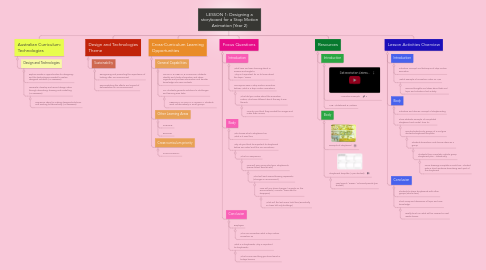
1. Australian Curriculum: Technologies
1.1. Design and Technologies
1.1.1. Explore needs or opportunities for designing, and the technologies needed to realise designed solutions (ACTDEP005)
1.1.2. Generate, develop and record design ideas through describing, drawing and modelling (ACTDEP006)
1.1.2.1. Sequence steps for making designed solutions and working collaboratively (ACTDEP009)
2. Design and Technologies Theme
2.1. Sustainability
2.1.1. Recognising and promoting the importance of looking after our environment
2.1.2. Demonstrating the affects and impact of deforestation on our environment
3. Cross-Curriculum Learning Opportunities
3.1. General Capabilities
3.1.1. CRITICAL & CREATIVE THINKING: Students identify and clarify information and ideas, organise and process information and transfer knowledge into new contexts
3.1.2. ICT: Students generate solutions to challenges and learning area tasks
3.1.2.1. PERSONAL & SOCIAL CAPABILITY: Students work collaboratively in small groups
3.2. Other Learning Areas
3.2.1. SCIENCE
3.2.2. ENGLISH
3.3. Cross-curriculum priority
3.3.1. SUSTAINABILITY
4. Focus Questions
4.1. Introduction
4.1.1. What have we been learning about in Science and English? Why is it important for us to know about this topic / issue?
4.1.2. Has anyone seen a stop motion animation before? What is a stop motion animation?
4.1.2.1. What did you notice about the animation video? What was different about the way it was filmed?
4.1.2.1.1. How do you think they created the images and make them move?
4.2. Body
4.2.1. Who knows what a storyboard is? What is it used for?
4.2.2. Why do you think its important to storyboard before we make/ and film our animation?
4.2.2.1. What is a sequence?
4.2.2.1.1. How will your group start your storyboard? (Dense forest, animals etc.)
4.3. Conclusion
4.3.1. Employee
4.3.1.1. Who can remember what a stop motion animation is?
4.3.2. What is a storyboard? Why is important to storyboard?
4.3.2.1. What is one new thing you have learnt in today’s lesson?
5. Resources
5.1. Introduction
5.1.1. Animation Example
5.1.2. IWB, Whiteboard & Markers
5.2. Body
5.2.1. Example of storyboard
5.2.2. Storyboard template (1 per student)
5.2.2.1. Lead pencil / eraser / coloured pencils (per student)
6. Lesson Activities Overview
6.1. Introduction
6.1.1. Introduce concept and technique of stop motion animation
6.1.2. Watch example of animation video on IWB
6.1.2.1. Discuss thoughts and ideas about task and topic and introduce first activity
6.2. Body
6.2.1. Introduce and discuss concept of storyboarding
6.2.2. Show students example of completed storyboard and model 'how to'.
6.2.2.1. Divide students into groups of 3 and give students storyboard template
6.2.2.1.1. Students brainstorm and discuss ideas as a group
6.3. Conclusion
6.3.1. Students to share storyboards with other groups (whole class)
6.3.2. Short recap and discussion of topic and new knowledge.
6.3.2.1. Briefly touch on what will be covered in next weeks lesson.
